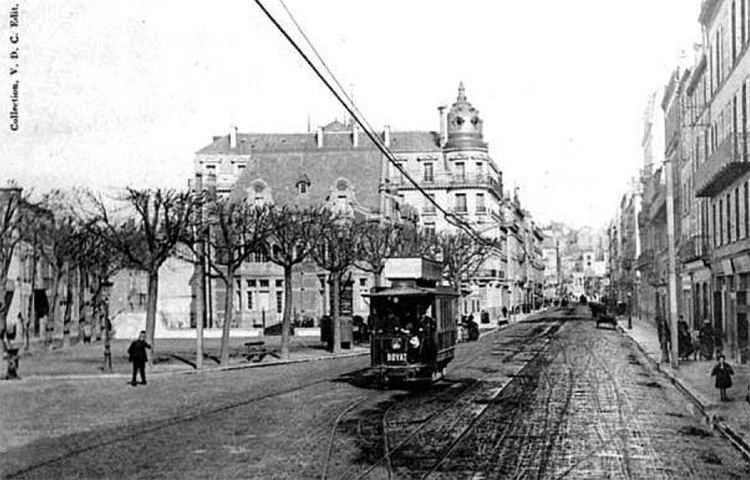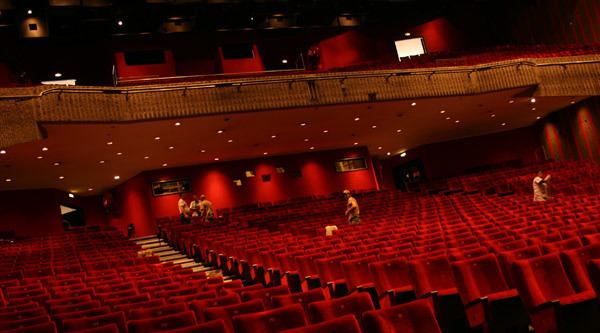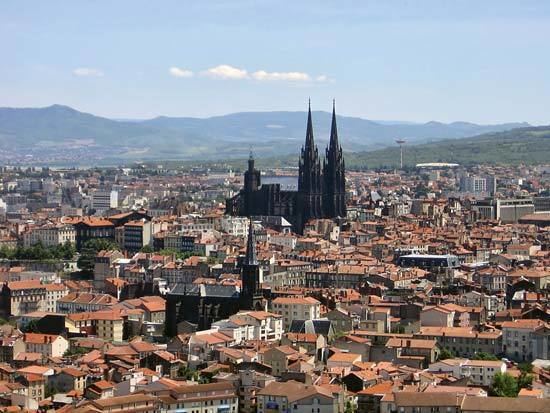Country Region Auvergne Population 139,006 (2008) | Area 300 km2 Mayor Olivier Bianchi | |
 | ||
Points of interest Clermont-Ferrand Cathedral, Basilica of Notre-Dame du Port, Vulcania | ||
Map of Clermont-Ferrand
Clermont-Ferrand ([klɛʁmɔ̃ fɛʁɑ̃], Auvergnat Clarmont-Ferrand or Clarmont d'Auvèrnhe, Latin: Augustonemetum) is a city and commune of France, in the Auvergne-Rhône-Alpes region, with a population of 141,569 (2012). Its metropolitan area had 467,178 inhabitants at the 2011 census. It is the prefecture (capital) of the Puy-de-Dôme department. Olivier Bianchi is its current mayor.
Contents
- Map of Clermont Ferrand
- Clermontferrand auvergne france
- Motion hd clermontferrand
- Name
- Prehistoric and Roman
- Early Middle Ages
- Middle Ages
- Early Modern and Modern eras
- Climate
- Economy
- Transport
- Education
- Religious architecture
- Parks and gardens
- Culture
- Sport
- People born in Clermont Ferrand
- People who have lived in Clermont Ferrand
- Town twinnings
- References

Clermont-Ferrand sits on the plain of Limagne in the Massif Central and is surrounded by a major industrial area. The city is famous for the chain of volcanoes, the Chaîne des Puys surrounding it. The famous dormant volcano Puy de Dôme (10 kilometres (6 miles) from the city) is one of the highest of these and well known for the telecommunication antennas that sit on its top and are visible from far away.

Clermont-Ferrand is also famous for hosting the Clermont-Ferrand International Short Film Festival (Festival du Court-Métrage de Clermont-Ferrand), one of the world's leading international festivals for short films, as well as the corporate headquarters of Michelin, the global tyre company created more than 100 years ago in the city.

Clermont-Ferrand's most famous public square is Place de Jaude, on which stands a grand statue of Vercingetorix sitting imperiously on a horse and holding a sword. The inscription reads: J'ai pris les armes pour la liberté de tous (I took up arms for the liberty of all). This statue was sculpted by Frédéric Bartholdi, who also created the Statue of Liberty.
Clermontferrand auvergne france
Motion hd clermontferrand
Name
Clermont-Ferrand's first name was Augusta Nemetum. It was born on the central knoll where the cathedral is situated today, known then as Nemossos. It overlooked the capital of Gaulish Avernie. The fortified castle of Clarus Mons gave its name to the whole town in 848, to which the small episcopal town of Montferrand was attached in 1731, together taking the name of Clermont-Ferrand. The old part of Clermont is delimited by the route of the ramparts, as they existed at the end of the Middle Ages. The town of Clermont-Ferrand came about with the joining together of two separate towns, Clermont and Montferrand, which was decreed by Louis XIII and confirmed by Louis XV.
Prehistoric and Roman
Clermont ranks among the oldest cities of France. The first known mention was by the Greek geographer Strabo, who called it the "metropolis of the Arverni" (meaning their oppidum, civitas or tribal capital). The city was at that time called Nemessos – a Gaulish word for a sacred forest, and was situated on the mound where the current cathedral of Clermont-Ferrand has been constructed. It was somewhere in the area around Nemossos that the Arverni chieftain Vercingetorix (later to head a unified Gallic resistance to Roman invasion under Julius Caesar) was born in around 72 BC. Also, Nemossos was situated not far from the plateau of Gergovia, where Vercingetorix pushed back the Roman assault at the Battle of Gergovia in 52 BC. After the Roman conquest, the city became known as Augustonemetum sometime in the 1st century, a name which combined its original Gallic name with that of the Emperor Augustus. Its population was estimated at 15,000–30,000 in the 2nd century, making it one of the largest cities of Roman Gaul. It then became Arvernis in the 3rd century (taking its name, like other Gallic cities in this era, from the people who lived within its walls), and expanded until the mid 3rd century.
Early Middle Ages
The city became the seat of a bishop in the 5th century, at the time of the bishop Namatius or Saint Namace, who built a cathedral here described by Gregory of Tours. Clermont went through a dark period after the disappearance of the Roman Empire and during the whole High Middle Ages, marked by pillaging by the peoples who invaded Gaul. Between 471 and 475, Auvergne was often the target of Visigothic expansion, and the city was frequently besieged, including once by Euric. Although defended by Sidonius Apollinaris, at the head of the diocese from 468 to 486, and the patrician Ecdicius, the city was ceded to the Visigoths by emperor Julius Nepos in 475 and became part of the Visigothic kingdom until 507. A generation later, it became part of the Kingdom of the Franks. On 8 November 535 the first Council of Clermont opened at Arvernis (Clermont), with fifteen bishops participating, including Caesarius of Arles, Nizier of Lyons (bishop of Trier) and Saint Hilarius, bishop of Mende. Sixteen decrees were made there, notably the second canon that recalls that the granting of episcopal dignity must be according to the merits and not as a result of intrigues.
In 570, Bishop Avitus left the Jews of his town (who numbered over 500) the alternatives of baptism or expulsion.
In 848, the city was renamed Clairmont, after the castle Clarus Mons. During this era, it was an episcopal city ruled by its bishop. Clermont was not spared by the Vikings at the time of the weakening of the Carolingian Empire: it was ravaged by the Normans under Hastein or Hastingen in 862 and 864 and, while its bishop Sigon carried out reconstruction work, again in 898 (or 910, according to some sources). Bishop Étienne II built a new Roman cathedral on the site of the current cathedral, consecrated in 946 but (apart from the towers, only replaced by the current ones in the 19th century, and some parts of the crypt, still visible) destroyed to build the current Gothic cathedral.
Middle Ages
Clermont was the starting point of the First Crusade, in which Christendom sought to free Jerusalem from Muslim domination: Pope Urban II preached the crusade there in 1095, at the Second Council of Clermont. In 1120, following repeated crises between the counts of Auvergne and the bishops of Clermont and in order to counteract the clergy’s power, the counts founded the rival city of Montferrand on a mound next to the fortifications of Clermont, on the model of the new cities of the Midi springing up in the 12th and 13th centuries. Until the early modern period, the two remained separate cities: Clermont, an episcopal city; Montferrand, a comital one.
Early Modern and Modern eras
Clermont became a royal city in 1551, and in 1610, the inseparable property of the Crown. On 15 April 1630 the Edict of Troyes (the First Edict of Union) forcibly joined the two cities of Clermont and Montferrand. This union was confirmed in 1731 by Louis XV with the Second Edict of Union. At this time, Montferrand was no more than a satellite city of Clermont, in which condition it remained until the beginning of the 20th century. Wishing to retain its independence, Montferrand made three demands for independence, in 1789, 1848, and 1863.
In the 20th century, construction of the Michelin factories and of city gardens, which shaped the modern Clermont-Ferrand, definitively reunited Clermont and Montferrand. But even today, although the two cities have been amalgamated, one may find in Clermont-Ferrand two distinct downtowns, and Montferrand still retains a strong identity.
Climate
The city is in the rain shadow of the Chaîne des Puys, giving it one of the driest climates in metropolitan France, except for a few places around the Mediterranean Sea. The mountains also block most of the oceanic influence of the Atlantic, which creates a climate much more continental than nearby cities west or north of the mountains, like Limoges and Montluçon. Thus the city has comparatively cold winters and hot summers. From November to March, frost is very frequent, and the city, being at the bottom of a valley, is frequently subject to temperature inversion, in which the mountains are sunny and warm, and the plain is freezing cold and cloudy. Snow is quite common, although usually short-lived and light. Summer temperatures often exceed 35 °C (95 °F), with sometimes violent thunderstorms.
Economy
Food production and processing as well as engineering are major employers in the area, as are the many research facilities of major computer software and pharmaceutical companies.
The city's industry was for a long time linked to the French tyre manufacturer Michelin, which created the radial tyre and grew up from Clermont-Ferrand to become a worldwide leader in its industry. For most of the 20th century, it had extensive factories throughout the city, employing up to 30,000 workers. While the company has maintained its headquarters in the city, most of the manufacturing is now done in foreign countries. This downsizing took place gradually, allowing the city to court new investment in other industries, avoiding the fate of many post-industrial cities and keeping it a very wealthy and prosperous area home of many high-income executives.
Transport
The main railway station has connections to Paris and several regional destinations: Lyon, Moulins via Vichy, Le Puy-en-Velay, Aurillac, Nîmes, Issoire, Montluçon and Thiers.
The motorway A71 connects Clermont-Ferrand with Orléans and Bourges, the A75 with Montpellier and the A89 with Bordeaux, Lyon and Saint-Étienne (A72). The airport offers mainly flights within France. There is a flight between Southampton and Clermont-Ferrand, operated by Flybe from May to October. Recently, Clermont-Ferrand was France's first city to get a new Translohr transit system, the Clermont-Ferrand Tramway, thereby linking the city's north and south neighbourhoods.
The TGV will arrive in Auvergne after 2030. It will be one of the last regions to not have a TGV stop.
Education
Education is also an important factor in the economy of Clermont-Ferrand. The Université Blaise Pascal and Université d'Auvergne are located there and have a total student population of over 37,000, along with university faculty and staff (on 1 January 2017, these universities merged into Université Clermont Auvergne, UCA).
With around 1,000 students SIGMA Clermont is the biggest engineering graduate school in the city.
A division of Polytech (an engineering school) located in Clermont-Ferrand made the news because two of its students, Laurent Bonomo and Gabriel Ferez, were murdered in June 2008 while enrolled in a program at Imperial College in London in what was to be known as the New Cross double murder.
Religious architecture
Clermont-Ferrand has two famous churches. One is Notre-Dame du Port, a Romanesque church which was built during the 11th and 12th centuries (the bell tower and was rebuilt during the 19th century). It was nominated as a World Heritage Site by UNESCO in 1998. The other is Clermont-Ferrand Cathedral (Cathédrale Notre-Dame-de-l'Assomption de Clermont-Ferrand), built in Gothic style between the 13th and the 19th centuries.
Parks and gardens
Culture
Clermont-Ferrand was the home of mathematician and philosopher Blaise Pascal who tested Evangelista Torricelli's hypothesis concerning the influence of gas pressure on liquid equilibrium. This is the experiment where a vacuum is created in a mercury tube: Pascal's experiment had his brother-in-law carry a barometer to the top of the Puy-de-Dôme. The Université Blaise-Pascal (or Clermont-Ferrand II) is located primarily in the city and is named after him.
Clermont-Ferrand also hosts the Clermont-Ferrand International Short Film Festival, the world's first international short film festival which originated in 1979. This festival, which brings thousands of people every year (137,000 in 2008) to the city, is the second French film Festival after Cannes in term of visitors, but the first one regarding the number of spectators (in Cannes visitors are not allowed in theatres, only professionals). This festival has revealed many young talented directors now well known in France and internationally such as Mathieu Kassovitz, Cédric Klapisch and Éric Zonka.
Beside the short film festival, Clermont-Ferrand hosts more than twenty music, film, dance, theatre and video and digital art festivals every year. With more than 800 artistic groups from dance to music, Clermont-Ferrand and the Auvergne region's cultural life is important in France. One of the city's nicknames is "France's Liverpool". Groups such as The Elderberries or Cocoon were formed there.
Additionally, the city was the subject of the acclaimed documentary The Sorrow and the Pity, which used Clermont-Ferrand as the basis of the film, which told the story of France under Nazi occupation and the Vichy regime of Marshal Pétain. Pierre Laval, Pétain's "handman" was an Auvergnat.
My Night at Maud's (French: Ma nuit chez Maud) a 1969 French drama film by Éric Rohmer was set and filmed in Clermont-Ferrand in and around Christmas Eve. It is the third film (fourth in order of release) in his series of Six Moral Tales. One of the main themes of the film concerns Pascal's Wager who's author was born in the city in 1623.
Sport
A racing circuit, the Charade Circuit, close to the city, using closed-off public roads held the French Grand Prix in 1965, 1969, 1970 and 1972. It was a daunting circuit, with such harsh elevation changes that caused some drivers to be ill as they drove. Winners included Jim Clark, Jackie Stewart (twice), and Jochen Rindt.
Clermont-Ferrand has some experience in hosting major international sports tournaments such as the FIBA EuroBasket 1999.
The city is also host to a rugby union club competing at international level, ASM Clermont Auvergne, as well as Clermont Foot Auvergne, a football club that has competed in France's second division, Ligue 2, since the 2007–08 season.
In the sevens version of rugby union, Clermont-Ferrand has hosted the France Women's Sevens, the final event in each season's World Rugby Women's Sevens Series, since 2016.
People born in Clermont-Ferrand
People who have lived in Clermont-Ferrand
Town twinnings
Clermont-Ferrand is twinned with:
